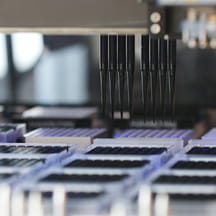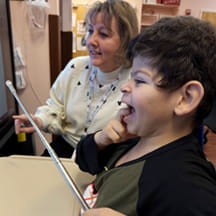The prospect of a newborn baby undergoing open-heart surgery is a nightmare for any parent, but for Felisa and Jared Garcia it was even more worrisome. Their daughter, Lola, was born with transposition of the great arteries and needed arterial switch surgery. The complicated procedure would likely require a blood transfusion—something that contradicted the Garcias' deeply-held religious beliefs as Jehovah's Witnesses.
"We felt fear and anxiety as to what this (procedure) would entail and if she could survive the surgery," Felisa Garcia says. "But when the doctors said that she will most likely need a blood transfusion, my heart sank all the way to the floor. Jared and I felt lost. We didn't know what to do."
The Garcias' search for a hospital willing to attempt the complex surgery without a blood transfusion led them to Lucile Packard Children's Hospital Stanford. "This took a huge weight off our shoulders," Felisa says. "We hadn't slept for days and when we heard they would accept Lola we finally had some peace."
Tiny infant requires a novel approach
Packard Children's had previously performed bloodless open-heart surgeries, but never before on a patient as small as Lola. At just 7 pounds, she was less than half the weight ordinarily considered for bloodless surgery.
In fact, a bloodless arterial switch surgery had never before been performed anywhere in North America on an infant as small as Lola. And with good reason. The newborn's size presented surgeons with several obstacles to a bloodless procedure. Primary among them: a limited volume of available blood.
Arterial switch surgery typically requires use of a heart-lung machine which pumps a patient's blood through a circuit of tubing and membranes for re-oxygenation. The machine needs enough fluid volume to complete the circuit, and typically that extra fluid comes from donated blood product. To safely perform the procedure on Lola would require a completely revamped approach.
Two factors key to a successful surgery
In the days leading up to the procedure Frank Hanley and Katsuhide Maeda, along with their cardiothoracic surgical team at Packard Children's, formulated a strategy to perform this bloodless surgery. Their plan hinged on two factors:
- Miniaturizing the heart-lung machine setup. Reducing the machine's containers and the length of the circuit tubing would decrease the amount of fluid necessary. These adjustments cut the amount of fluid the heart-lung machine required by about 50 percent.
- Meticulous surgical techniques. A certain amount of blood loss is expected in a procedure like this, so making sure every move was made with utmost precision was paramount in keeping blood loss, and thus the need for a blood transfusion, to a minimum.
The surgeons were prepared to administer blood if Lola's red blood cell count dipped below a pre-determined safe threshold. But after the seven-hour operation, Hanley delivered the news the Garcias were hoping for: Lola's surgery was a success and she didn't need a blood transfusion.
"It's extremely gratifying," says Hanley, chief of pediatric cardiac surgery at the Betty Irene Moore Children's Heart Center at Packard Children's. "To not only successfully perform the operation on a child but to do it in a way that meets the family's religious, cultural or personal desires—that's gratifying."
Bloodless surgery carries medical benefits
While religious preferences drove the decision to forego a blood transfusion in Lola's procedure, it's not the only determining factor. Bloodless surgeries have medical benefits as well. Blood transfusions can increase the likelihood of complications in surgery and patients have demonstrated faster recovery times following bloodless surgeries, according to Hanley. He says his team performs a risk-benefit analysis for each surgical patient to determine if a bloodless procedure is appropriate.
Lola remains the smallest patient to have a bloodless open-heart surgery at Packard Children's, but Hanley says the hospital has since performed about 20 bloodless surgeries on babies weighing less than 10 kilograms. He expects that number to grow as the technology and techniques around bloodless pediatric surgery continue to improve.
A family forever
Today, Lola is an active, happy toddler. Mom calls her a "tough cookie" who loves to dance, play with cars and chase her older brother around the house. Lola won't remember her surgery, but her parents will never forget the surgeons who preserved their religious values and saved their daughter's life.
"We didn't know if we were going to lose her," Felisa says. "When Dr. Hanley came out and told us that (the surgery) was a success and she did not require a blood transfusion, words cannot describe the happiness Jared and I felt. We knew that our little Miss Lola was on her way to recovery."


